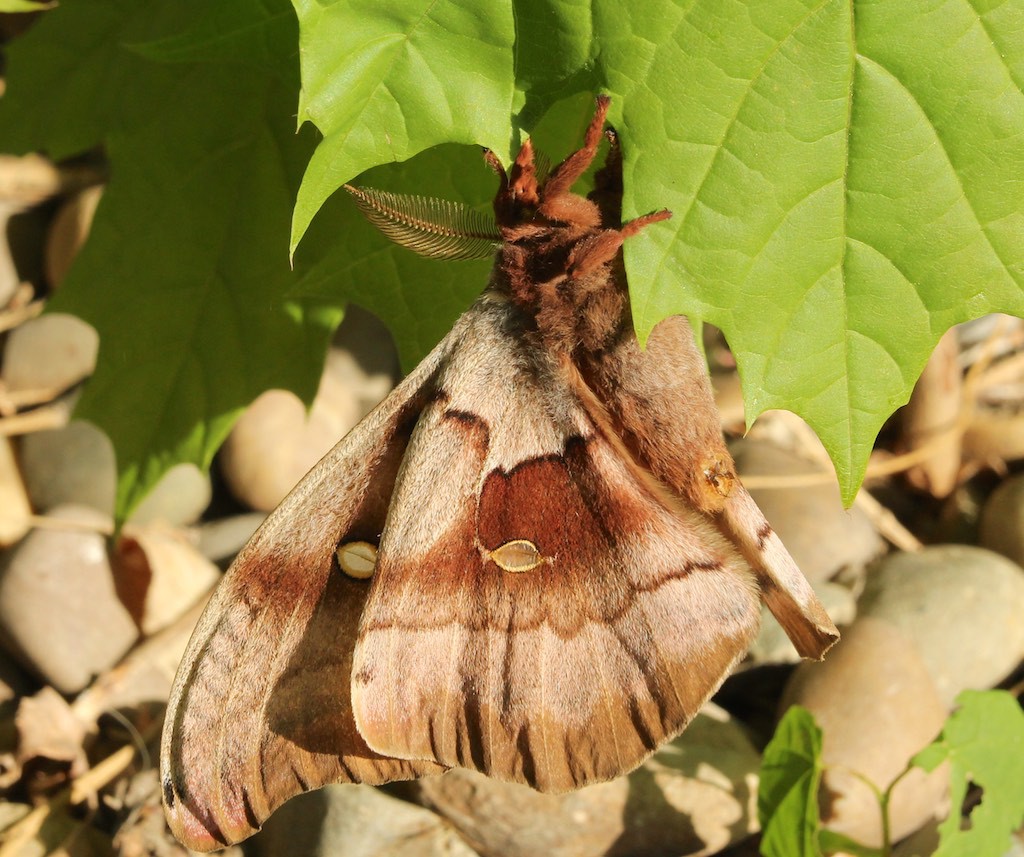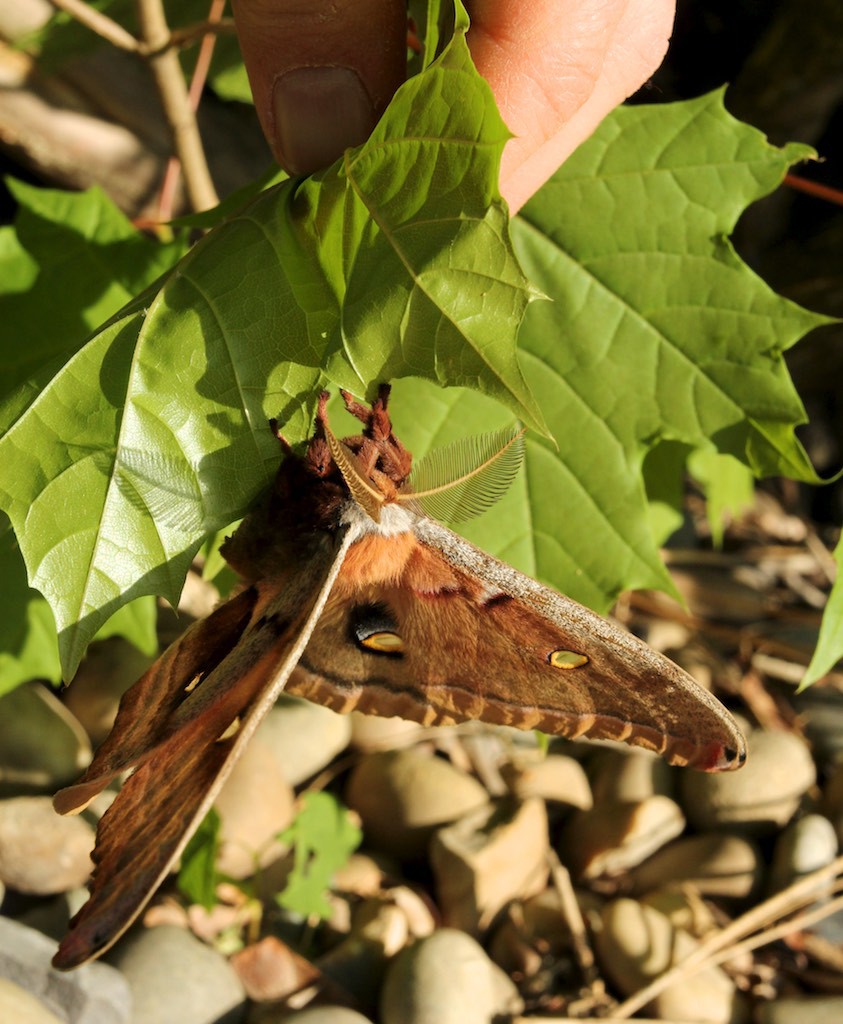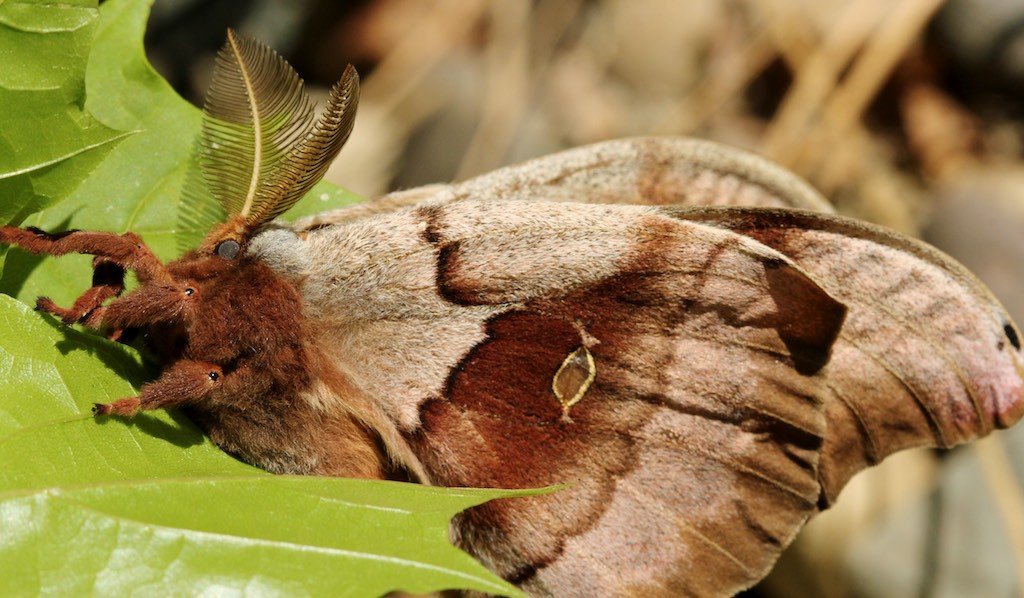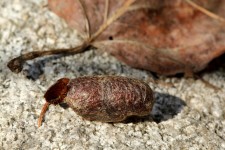Fluttering at the base of a bush caught my attention. I thought it was a butterfly but the antennae indicated it was a moth–a moth with a hairy body that resembled a tarantula. The moth was huge with a wingspan of nearly 5.5 inches.
The polyphemus moth is unlikely to be confused with any other moth in the Pacific Northwest because of its large size, tan color and translucent eyespots. I’ve never heard of the polyphemus moth before but I have heard of (but not seen) other giant silk moths–Luna and Cecropia (the largest moth in North America).
The polyphemus moth presumably was named after Polyphemus, a giant cyclops in Greek mythology, since the moth has large eyespots on its wings.
Giant silk moths shouldn’t be confused with the silkworm moths that produce silk (Bombycidae family) for manufacture. Instead the name for giant silk moths (family Saturniidae) comes from the moths using fine silk to spin their cocoons.
Polyphemus moths are the most widely distributed silk moths in North America, ranging from east coast to west coast and throughout southern Canada. Why haven’t I seen one before?
The moths are mainly nocturnal and can be found near porch lights left on overnight. The one I found was on a bush next to a porch light.

If it wasn’t windy, I wouldn’t have noticed the fluttering. Since the moths look like dead leaves or bark when their wings are folded, they can be hard to find.
The adults don’t live long either–one to two weeks. Without mouthparts, the moths rely on stored nutrients from their caterpillar stage to carry out their mission–mating.
Most of the moths emerge from their cocoons within one week of each other to ensure the males and females find each other. Their emergence is triggered by warm day and night temperatures which ranges from May to July in their northern range.
They usually emerge during the day to allow their wings to inflate and dry before nighttime. Then at night the female releases pheromones (scents) that the male detects from far away with his elaborate antennae.
After mating, the female finds suitable plants to lay three to five eggs on the undersides of leaves. She may lay more than 100 eggs but on different plants to ensure the caterpillars have access to enough food. The female lays the eggs on certain plants so the caterpillar has food right away. These plants include oak, maple, pine, birch, ash, aspen, elderberry, alder, sassafras, blueberry, grapes, willow, chokecherry, pin cherry, serviceberry and hawthorn.

The eggs hatch within 10 to 14 days and the newly-hatched caterpillar eats its eggshell. Then the caterpillar begins an eating frenzy that allows its body weight to increase by a factor of more than 10,000. The caterpillars start out at three millimeters in length and increases to 70 to 100 millimeters.
By mid- to late August the bright green caterpillars reach full size. Since the caterpillars don’t want to lure in predators with marks left by feeding, they journey to a new plant to spin a cocoon.
Polyphemus moths spin oval-shaped cocoons and incorporate some leaves from the plant. Once inside the cocoon, the caterpillar enters the pupa stage and changes into a moth. However, the pupa stays in diapause (a resting state) for the winter until the temperatures warm in the spring. The moth’s brief appearance provides us a chance to see one of our largest moths.
Originally posted May 2015. Updated January 2024.






I saw one of these big beauties today, resting on a concrete wall . Never saw one up close before and was able to get nice close up pictures. Maybe it was lost because this was in Baltimore Md. A long way from Idaho !
Thank you for this very informative article! One of these moths planted himself on our white wall underneath a light in our backyard staying there for two days. This makes sense because our house is under an immense oak tree. We have never seen one before so your information is very helpful and we will be on the lookout for more next Spring. By the way, we are in the foothills of the Sierra Nevada in California.
I have one hanging on out concrete wall ! It’s April , in Northern Ky!
Awesome! Thanks for sharing.
Laura
I live in rural North Idaho and I found a cocoon while looking for morel mushrooms. I took it home and today it “hatched.” The moth crawled out, dragging an extended body and very stubby wings, but within a couple hours the wings inflated and the body shrunk. Now the moth is hanging out on our outside deck looking great. I suspect he’ll be gone by tomorrow morning. (Huge antennas suggest a male)
Awesome!
We found a large male on our cabin deck in Granite Oregon. He climbed on my finger, then the wind caught his wings and he flew into a pine tree.
I found I believe a pair of these huge moths this morning just before my front porch. I live in downtown CDA and will try to send in pictures later today.
I saw one today and was confused after reading this article. It was in New Jersey a long way from Idaho.
Thanks for asking! Polyphemus moths are found in every state in the US except Arizona and New Mexico according to Butterflies and Moths of North America. Enjoy watching them!
Took great photos of one today. Found in South Florida this morning. I never seen one until today!
Wonderful!
Thanks for the post – saw one this morning while trying to check out a beetle – it was hidden well and I jumped a bit when I first saw it.
Today we had a male taking a rest on our flower stand. It was amazing ! We live outside of Philadelphia.
Awesome! Thanks for sharing.
Laura
I found one in our yard during the day with battered wings. He has feather like antennae, which I understNd depicts the male. He cannot fly so to protect him from being picked off by a bird, we put him in our butterfly habitat. Now I don’t know what to do with him. Any advice in what to do to help him? Do they drink?
Hi Jessica,
Thanks for sharing. Adults don’t have mouthparts so they don’t eat or drink. Since the moth can’t fly and adults only live for one to two weeks, enjoy watching him in your butterfly habitat.
Laura
By the way, we live in northern Ohio.
We found one on the threshold of our front door. At first I thought it was a leaf and thought it odd because the oak leaves were raked up. This was in June in northern Ohio. The light at the front of the house is left on all night so I guess that is what attracted him. I was on my way out so I didn’t get a chance to watch him for more than a few minutes but I did take a couple pictures.
Thanks for sharing!
Laura
Saw 2 together this morning in Illinois. One smaller than the other so am guessing 1 male & 1 female. Wish I could post the picture!
Awesome! Thanks for sharing.
Laura
I found one of these months on my deck this morning, got a great picture, it is awesome!!!
Wonderful!
Laura
I found one today on my window. and was so excited . Took pictures of him and put out sos. I had no idea what it was . Got lots of information back . Thanks so much . He is awesome and ugly at the same time . God does create some wonderful things .
I have one on my house today, right below our porch light. We live in the Sierras in Northern CA. He or She is beautiful and very large, about the size of a hummingbird.
Evidently I can’t add a picture to this site, but one has visited my garage light for 3 of the last 4 nights. Here in eastern Punta Gorda FL.
I have one on back porch light post today. Very cool, I had to look it up on line and found this lovely article. Thank you for the great information. Washington state
Just seen a male hanging from a tire in the parking lot of work. Never seen such a large moth, thought it was a dead leaf at first. I am not Easton, PA.
Dunno if it was one of these moths which I saw, but I saw what appeared to be a 4″ tan moth from shoulder to wingtip, and I live in Portland, Oregon.
It happened last fall, at night. It flew into the corner on my porch, as if it was a kamikaze bird. It crashed and I only saw it briefly, but it did not resemble the Pandora moth of central Oregon, whose wings have more contrasted designs, and eyespots. This was more of a plain, tan moth. I don’t know why it flew to the corner and crashed, but it did. It fell, and almost instantaneously after that, I heard a very audible flutter flutter flutter sound in a bush which was ten feet away. Then the fluttering stopped and I went inside.
I don’t think it was a Pandora moth because it was substantially bigger. I would like to know what this thing was doing in Portland, though.
Polyphemus moths are found in every state except Arizona and Nevada according to Animal Diversity Web, so their occurrence in Portland is feasible. Thanks for sharing!
On this day 9/14/24 11am, there’s one hanging on my storm door in Rex, GA